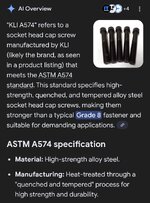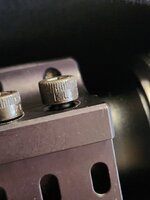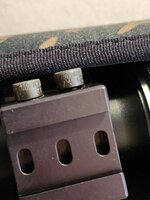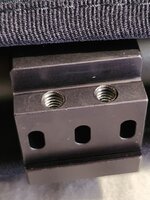Navigation
Install the app
How to install the app on iOS
Follow along with the video below to see how to install our site as a web app on your home screen.
Note: This feature may not be available in some browsers.
More options
Style variation
You are using an out of date browser. It may not display this or other websites correctly.
You should upgrade or use an alternative browser.
You should upgrade or use an alternative browser.
UM Tikka rings are not recommended for cartridges larger than 7mm PRC?
- Thread starter Cdnance
- Start date
Fowl Play
WKR
- Joined
- Oct 1, 2016
- Messages
- 773
I hear you… I’ll refrain from continuing the drama. And my FS of 2 comment definitely stems from my industry but would be laughably low is others like you mention.This is getting amusing. I bet there are more than one functional way to skin this cat, as well as some very none functional ways.
A wheel hub is a shock loaded friction joint, and clearly works very well.
Lugs on a rifle bolt are clearly relying on one structure mechanically preventing the movement of another and works well.
The question is what works best in the context from a durability and function perspective? I'm willing to bet a combination of friction and pin.
Safety factors of two sound so low, but that is because I'm use to life safety uses where 10 is considered standard (not professionally, only from dabbling in rigging, overhead rescue, and tree work).
Friction can 100% be used effectively to carry shear and is used all over the place where lots of large fasteners can fit. Interestingly enough, since you mentioned it, many wheel hubs actually have shear features if you look at them. Not dedicated pins, but there will be an indentation on one with mating protrusion on the other — usually around the hub. Though for small vehicles some are purely frictional.
The problem with scope rings are the fasteners are always laughably small. #10 or even 1/4” fasteners would honestly have to be used to allow for high safety factors.
It’s hunting season and I’m not that bored, but maybe one of these days I’ll sit down and pencil out an example calc for a magnum cartridge. My gut says even trying to get a FS of 2 might not be possible purely using friction with the given fastener size.
Sundodger
WKR
Not going to go into credentials or experience, (I have plenty) but I disagree with you wholeheartedly at a very basic level. Even suggesting that FEA is required or is the best way to calculate preload in a joint is wrong.
Edit: I have gone back and read through many of your other comments on this thread and whole heartedly agree with the difficulties of a bolted joint design you mention. Threadforms, coating, frictional factors, etc all make determining preload consistently a nightmare. And it shows that you have done this before, probably at an intimate level. That is precisely why you use shear pins. Especially in a situation like this where you are not going to go through the process (money) to get test based material frictional factors or lubricant K factors, or specify some crazy high toleranced thread form, or take acceleration data from some crazy lightweight rifle with some new fangled hot cartridge, all the while trying to account for the vast majority of installs being done with sub par uncalibrated tools with untrained individuals. There is just too much variability in all of it. Especially when dealing with two very small fasteners per mount.
Still have the same problem with mounts to scope tube, but at least on the good mounts you have 4x fasteners per mount. Helps close the friction problem easier.
Oh, looks like that FMEA comment was a miscommunication. For some reason I was still in my head of a previous comment I made about designing rings from scratch with OEM standards would probably have higher dev costs than UM makes in a year. My bad, sorry about that, trying to do to much...
I agree, for simple joint loading, basic calculations on bar napkins or excel are all that are needed to get in the ballpark to allow torque/tension testing to begin.
I have no data to back this up, but I fear that the scope tube mounting might be a real tricky one, due to that aluminum tube possibly making the joint less rigid.
An engineer, a statistician, and a physicist are out hunting. They spot a buck, and each take turn to try and shoot it.
The physicist goes first. He pulls out his notebook and calculates the trajectory of the bullet, assuming it is a perfect sphere in a vacuum. The bullet falls 20 yards short of the deer.
The engineer goes second. He pulls out his engineers pad and book of projectile assumptions. Then he takes aim, and he fires. The bullet lands 20 yards passed the deer.
The statistician leaps in the air shouting, "We got it!"
The physicist goes first. He pulls out his notebook and calculates the trajectory of the bullet, assuming it is a perfect sphere in a vacuum. The bullet falls 20 yards short of the deer.
The engineer goes second. He pulls out his engineers pad and book of projectile assumptions. Then he takes aim, and he fires. The bullet lands 20 yards passed the deer.
The statistician leaps in the air shouting, "We got it!"
RyanT26
WKR
- Joined
- Apr 8, 2020
- Messages
- 1,547
Rokstock rollout, scope rings confusion, can’t wait for the Rok scope .
.
Every product is the best that’s ever been manufactured.
Every product is the best that’s ever been manufactured.
I hope the Rokscope is awesome. But someone else can do the beta testing. I’ll wait a couple years before I crack open my wallet.Rokstock rollout, scope rings confusion, can’t wait for the Rok scope.
Every product is the best that’s ever been manufactured.
BigCountry49
WKR
- Joined
- Nov 24, 2018
- Messages
- 384
I actually enjoy and encourage the engineering debate here. If left alone long enough something noteworthy will come of it, I’m sure. Everyone bashes on engineers but without them you have would companies building shit based on 20 pictures of what some user swears will always work.
Billy Goat
“MOMMY”
The redneck can enter the chat now.....
I'll just get a 6# 30mm tube and mount it in the rings and see if it moves with about 5 shots.
I'll just get a 6# 30mm tube and mount it in the rings and see if it moves with about 5 shots.
Just JB Weld everything. No fancy Devcon.The redneck can enter the chat now.....
I'll just get a 6# 30mm tube and mount it in the rings and see if it moves with about 5 shots.
That will thrill the engineers.
Chris_in_Idaho
WKR
- Joined
- Aug 20, 2021
- Messages
- 571
This has been an interesting typical thread.
I like UM but would like to offer some unsolicited customer feedback.
Retroactively placing a limit on a product many people have already purchased over the last couple years is like buying a 1 ton truck and then having the manufacturer say "surprise it's actually only a 1/2 ton" after they have your money.
I think in future scenarios like this it would come across better to put out a post/news blast/email saying "If you have purchased our Tikka Rings please note we've found for best performance on heavy recoiling rifles the base screws must be torqued to 60 in-lbs instead of 45 as previously recommended. You MUST use a properly calibrated in-lb torque wrench. Any questions feel free to call..."
I like UM but would like to offer some unsolicited customer feedback.
Retroactively placing a limit on a product many people have already purchased over the last couple years is like buying a 1 ton truck and then having the manufacturer say "surprise it's actually only a 1/2 ton" after they have your money.
I think in future scenarios like this it would come across better to put out a post/news blast/email saying "If you have purchased our Tikka Rings please note we've found for best performance on heavy recoiling rifles the base screws must be torqued to 60 in-lbs instead of 45 as previously recommended. You MUST use a properly calibrated in-lb torque wrench. Any questions feel free to call..."
Billy Goat
“MOMMY”
Just JB Weld everything. No fancy Devcon.
That will thrill the engineers.
That stuff is better than balin' wire.
Fowl Play
WKR
- Joined
- Oct 1, 2016
- Messages
- 773
Just in case I get a wild hair, can anyone confirm what size fasteners and grade of material the UM base fasteners are?
For reference, Sportsmatch medium rings use M4 and high rings actually use M5, both stamped 12.9 on the head which is a high strength steel. Ult ~180,000psi. Sportsmatch torque specs of 38 in-lbs and 55in-lbs for those sizes respectively are pretty spicy for those fastener sizes, and they likely used dry/degreased values to generate them. If I sub say a K factor of 0.15 in for a moderate lubricant like Loctite, those torque values can easily take you to 90% of ultimate strength of the fastener -- before even accounting for torque wrench variability.
For reference, Sportsmatch medium rings use M4 and high rings actually use M5, both stamped 12.9 on the head which is a high strength steel. Ult ~180,000psi. Sportsmatch torque specs of 38 in-lbs and 55in-lbs for those sizes respectively are pretty spicy for those fastener sizes, and they likely used dry/degreased values to generate them. If I sub say a K factor of 0.15 in for a moderate lubricant like Loctite, those torque values can easily take you to 90% of ultimate strength of the fastener -- before even accounting for torque wrench variability.
Light reading on the subject:
 bordenrifles.com
bordenrifles.com
Thoughts on Torquing Small Screws - Borden Accuracy
We often get asked questions regarding torquing of the scope base/rail screws on our actions. It has become accepted practice ion the firearms industry to focus on specifying torque values for all screws on a rifle. It is not prudent to use that technique on all screws on a bolt action receiver...
 bordenrifles.com
bordenrifles.com
WiscoHoundsman
WKR
Next time I have to adjust my scope I’ll use two uggas and a dugga and say that ain’t going anywhere!
- Joined
- Nov 7, 2018
- Messages
- 1,882
Just in case I get a wild hair, can anyone confirm what size fasteners and grade of material the UM base fasteners are?
For reference, Sportsmatch medium rings use M4 and high rings actually use M5, both stamped 12.9 on the head which is a high strength steel. Ult ~180,000psi. Sportsmatch torque specs of 38 in-lbs and 55in-lbs for those sizes respectively are pretty spicy for those fastener sizes, and they likely used dry/degreased values to generate them. If I sub say a K factor of 0.15 in for a moderate lubricant like Loctite, those torque values can easily take you to 90% of ultimate strength of the fastener -- before even accounting for torque wrench variability.
And yet…. They’ve worked for a lot of people
Sent from my iPhone using Tapatalk
Chris_in_Idaho
WKR
- Joined
- Aug 20, 2021
- Messages
- 571
I'm measuring 0.163" for the major thread diameter. They're marked KLI A574 USA.Just in case I get a wild hair, can anyone confirm what size fasteners and grade of material the UM base fasteners are?
I really doubt the grade of steel screw makes any difference when they're threaded into 6061 Aluminum. I would think any upgrade for more torque/clamping would require a threaded insert like a helicoil or timesert. But I'm no engineer...






Fowl Play
WKR
- Joined
- Oct 1, 2016
- Messages
- 773
Appreciate it! And yes, the female threads in the aluminum are the limiting factor.I'm measuring 0.163" for the major thread diameter. They're marked KLI A574 USA.
I really doubt the grade of steel screw makes any difference when they're threaded into 6061 Aluminum. I would think any upgrade for more torque/clamping would require a threaded insert like a helicoil or timesert. But I'm no engineer...
I'd imagine this situation is embarrassing to UM. Has anyone from UM responded to this thread? If so, I haven't seen it. Maybe too busy hunting?
My take...
I don't see Unknown Muntions or Unknown Suppressors as being R&D companies. One does machining and some gunsmithing, and the other does additive manufacturing.
Their strength, is getting product to market quickly which caters to a certain group of buyers.
My take...
I don't see Unknown Muntions or Unknown Suppressors as being R&D companies. One does machining and some gunsmithing, and the other does additive manufacturing.
Their strength, is getting product to market quickly which caters to a certain group of buyers.
Similar threads
Featured Video
Latest Articles
- TT#64 Josh Boyd Elk Hunting Strategies for Every Season
- Aaron Davidson of Gunwerks
- TT#63 Dirk Durham’s Art of Elk Calling
- BIG Buck Stories with the Dirty Giants Podcast
- TT#62 Brian Barney Hunting Bulls without Calling
- Hoyt Alpha AX-2 SD Review
- Kuiu Kenai vs Outdoor Vitals Vario Hooded Jacket Review
- Hoyt RX-9 Ultra Review
- Hunting Vampire Bucks & Building an Optics Kit
- Darton Sequel ST2 35 Review
